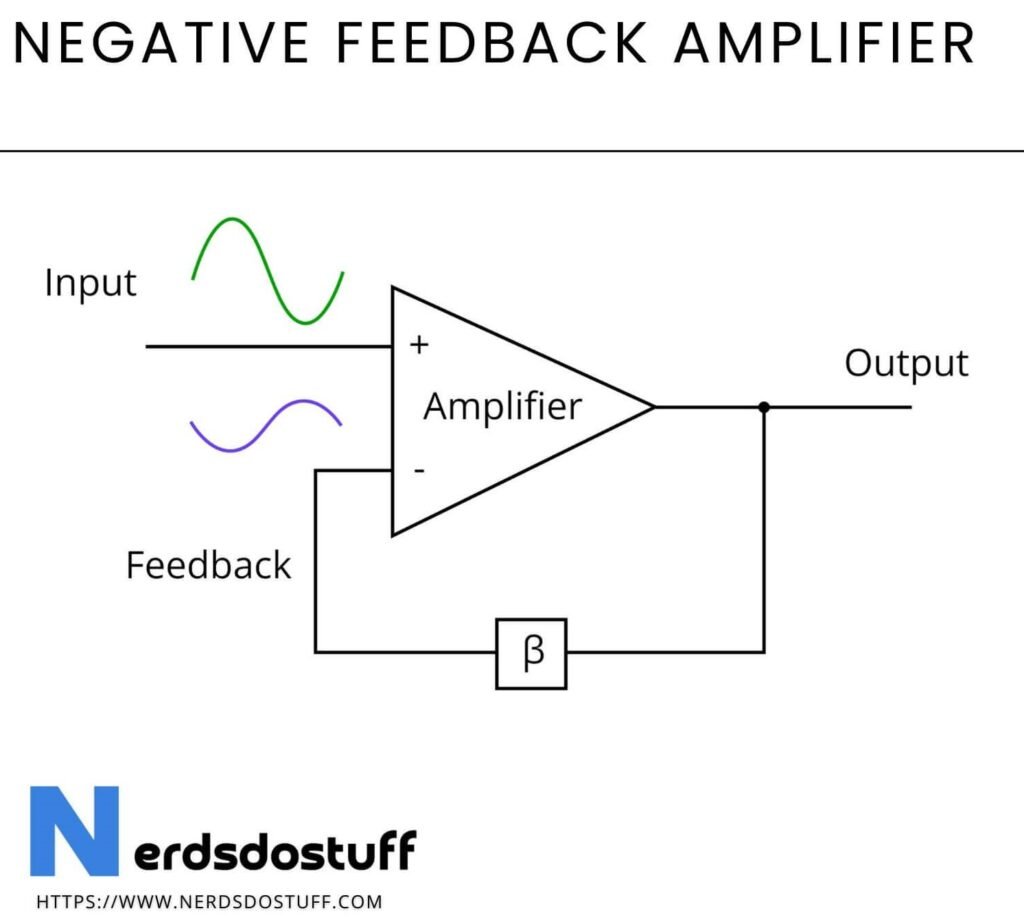What is Negative Feedback Amplifier ?
A negative feedback amplifier is an electronic circuit designed to stabilize and control the amplification of an input signal. In this configuration, a portion of the output signal is fed back to the input in such a way that it opposes the original input. This negative feedback mechanism helps regulate the amplifier’s gain, bandwidth, and distortion, leading to improved linearity and reduced sensitivity to component variations. Negative feedback amplifiers are widely used in audio, communication, and other electronic systems to enhance performance, minimize distortion, and maintain consistent output characteristics over a range of operating conditions. The incorporation of negative feedback contributes to increased stability and reliability in amplifier designs.
Why Negative Feedback Amplifier is used ?
Negative feedback amplifiers are extensively utilized in electronic systems due to their ability to enhance stability and improve the overall performance of amplification circuits. The introduction of negative feedback involves the comparison of the output signal with the desired input, allowing the system to automatically adjust and minimize discrepancies. This self-regulating mechanism plays a crucial role in stabilizing the amplifier’s operation, making it less susceptible to variations in component characteristics, temperature changes, or other external factors. The result is a more reliable and predictable amplifier that can consistently provide the desired level of amplification without introducing distortions or unwanted variations in the output signal.
Beyond stability, negative feedback amplifiers contribute to improved linearity and reduced distortion. By dynamically adjusting the amplification to counteract nonlinearities in the system, negative feedback ensures a more faithful reproduction of the input signal. This is particularly advantageous in applications such as audio amplification, where minimizing harmonic distortion is essential for achieving high-quality sound reproduction. Additionally, the precise control over gain, extended bandwidth, and reduced sensitivity to component variations further solidify the widespread use of negative feedback amplifiers in various electronic systems, ranging from audio equipment to communication devices.
Negative Feedback Amplifier Circuit Diagram

Working of Negative Feedback Amplifier
- Input Stage: The amplifier starts by accepting an input signal, which is then amplified in the initial stage. This stage is responsible for boosting the strength of the input signal.
- Comparison: A portion of the amplified output signal is fed back to a comparison point where it is compared with the original input signal. This comparison determines the error or the difference between the desired output and the actual output.
- Adjustment: The feedback network generates a correction signal based on the comparison result. This correction signal is then applied to the input, counteracting the error and reducing the amplification of the original input signal.
- Output Control: By continually adjusting the input based on the feedback, the negative feedback amplifier ensures that the output closely follows the desired input. This process not only stabilizes the amplifier’s gain but also improves linearity, bandwidth, and reduces distortion.
- Stability and Linearity: The negative feedback loop acts as a stabilizing mechanism, making the amplifier less sensitive to variations in component characteristics and external conditions. This results in a more predictable and linear response, contributing to the overall reliability and performance of the amplifier.
- Reduced Distortion: Negative feedback amplifiers tend to exhibit lower harmonic distortion compared to amplifiers without feedback. The correction mechanism helps minimize nonlinearities in the amplifier’s response, ensuring a more faithful reproduction of the input signal.
Applications of Negative Feedback Amplifier
- Audio Amplification: Negative feedback amplifiers are extensively used in audio systems, such as amplifiers for speakers and headphones. By reducing distortion and improving linearity, they contribute to the production of high-quality, clean sound with accurate frequency response.
- Instrumentation Amplifiers: In precision measurement and instrumentation applications, negative feedback amplifiers play a crucial role. Their ability to provide accurate amplification while minimizing errors makes them suitable for applications like medical instrumentation, data acquisition systems, and sensor interfaces.
- Operational Amplifiers (Op-Amps): Negative feedback is a fundamental feature in operational amplifiers. Op-amps with negative feedback are widely employed in various electronic circuits, including signal conditioning, filtering, and voltage regulation. The feedback allows for precise control over the amplifier’s gain and behavior.
- Voltage Regulators: Negative feedback amplifiers are essential components in voltage regulator circuits. By continuously adjusting the output voltage to match a reference level, these amplifiers stabilize and maintain a constant output voltage despite fluctuations in the input or load conditions.
- Communication Systems: Negative feedback amplifiers play a role in improving the performance of communication systems, particularly in radio frequency (RF) and microwave amplifiers. Their use helps maintain signal integrity, reduce noise, and enhance the overall reliability of the communication equipment.
- Power Amplifiers: Negative feedback is employed in power amplifiers, especially those used in high-fidelity audio applications. It helps control distortion, improve efficiency, and ensure the faithful reproduction of the input signal at higher power levels, making them suitable for applications like public address systems and home audio amplification.




